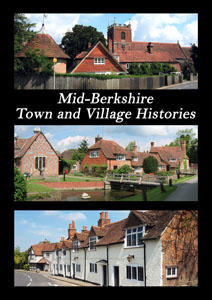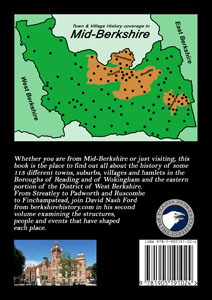 |
 |
||||||||
|
|
There are a number of ancient, and now disjointed, banks and ditches around Padworth, locally known as Grim's Ditch. The name indicates that
the Anglo-Saxon settlers in the area thought they were so impressive that they must have been built by the chief of their pagan gods, Woden, who was nicknamed Grim. In fact, the position
of the ditches indicate that they encircle the northern boundaries of Calleva, the Roman town of Silchester, just over the border in Hampshire. It is generally accepted that they were
constructed in post-Roman times as protection for the Romano-Britons still living at Silchester after the Roman army had left the country. At that time, Berkshire was a fast-growing
Anglo-Saxon colony and the new-comers would often attack the British urban populace. The Anglo-Saxon leader who settled in this precise area with his family was probably called Padda. Hence
the place became Padda's Farm or Padworth.
After the Norman Conquest, the manor was owned by the prominent Coudray family. They were resident throughout the 13th and 14th centuries but later inherited Sherborne
Coudray (now Sherborne St John) and Herriard in North Hampshire, which they seem to have preferred. They sold their residence in Padworth in 1586. A secondary manor called Hussey's lay near the border with Ufton and, by Tudor times, was run by the Perkins family of Ufton Robert
Manor (and later Ufton Court). Mr Richard Perkins let his brother, Francis, live at Pam Hall, the manor house of Hussey's, but a serious
dispute concerning the manor's overlordship arose with their neighbour, Sir Humphrey Forster of
Aldermaston House. Forster spent much time at the royal court and clearly thought himself socially above other Berkshire gentry. One day in 1534 he armed his servants with bows,
arrows, swords, shields, daggers and spears and they marched on Pam Hall. Finding Francis Perkins in in the hall, Sir Humphrey immediately began to assault him. He was only prevented from
killing the man by the pleas of his poor wife. Instead, he was escorted to Ufton Robert, where he was thrown at the feet of his brother, Richard Perkins, who was having breakfast. Sir
Humphrey then started on Richard, taking him by the hair and insisting that he keep his hands off the Forster lands in Padworth. Sir Humphrey drew his sword but eventually decided to leave.
He took Francis Perkins with him and threw him in his local Aldermaston lock-up for the night. The Perkins brothers took Sir Humphrey to court
at the Star Chamber but the uotycome of the case is unknown. It was
Richard Perkins' wife, Elizabeth, who later, as Lady Marvyn, instigated the famous dole of bread and cloth for the parishioners of Ufton and Padworth. It is supposed to have been set up in
thanks to the villagers for having helped her find her way home after getting lost in the woods in 1581. In September 1643, during the Civil War, roundhead troops passed through the area after having defeated the Royalists at the
First Battle of Newbury. In Padworth Gulley, however, Prince Rupert's cavalry managed to surprise them one last time. Three hundred men are
said to have been killed. They were buried in large pits in the parish churchyard. A memorial in the church porch tells their story. Just over a year later, more parliamentary troops
crossed the Kennet at Padworth whilst on their way to the Second Battle of Newbury. Padworth parish church is one of the smallest in the county. A fine Norman apsed building with decorative doorways, it was
almost completely constructed in about 1130. The interior features a medieval wall painting of St Nicholas and grand monuments to the Brightwell family and their heirs who built the present
Padworth House alongside. This is the main manor house of the parish and was in their hands from 1655. An in-law, Matthew Chitty Darby Griffith
later inherited the estate. He was a general in the grenadier guards, served with distinction in the Peninsula War. His descendants owned Padworth House well into the 20th century. The two Mortimer murderers, Abraham Tull and William Hawkins, were born and baptised in Padworth. Their parents were humble, honest and respected folk and the families both lived
in Ufton. In 1787, at the ages of nineteen and seventeen respectively, they waylaid an old labourer and bludgeoned him to death for the sake of eleven shillings, which they then failed to find on
his body. They were hanged on Mortimer Common, on a piece of land just within Ufton parish, now called Gibbet Piece. Read more history of Padworth and other nearby settlements, like Lower Padworth & Aldermaston Wharf, in David Nash Ford's book, 'Mid-Berkshire Town and Village Histories'.
Click to Order direct from the Author.
Whether you are
from Mid-Berkshire or just visiting, this book is the place to find
out all about the history of some 113 different towns, suburbs,
villages and hamlets in the Boroughs of Reading and of Wokingham and the eastern portion of the District of West Berkshire.
From Streatley to Padworth and Ruscombe to Finchampstead,
join David Nash Ford from
berkshirehistory.com in his second volume examining the structures, people and events
that have shaped each place. Some of these histories were first
published in part here on this website, but they have all been
considerably expanded and are joined by many new histories of places
often missed by historians, including those which only joined
Berkshire in 1911 or later. Click
for full details and purchase options. |
||||||||
| © Nash Ford Publishing 2004; Revised 2020. All Rights Reserved. | |||||||||





